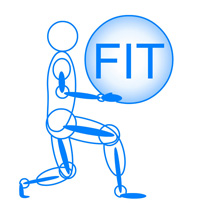Athletes stretch for top performance in their sports. This type of stretching is dynamic, meaning everything moves – the arms, legs, back and head. Athletes doing dynamic stretching move through the different stretches, but don’t hold them for more than a few seconds.
Employees stretch to turn back time. This reverses the slow, steady damage done to muscles when they aren’t used properly.
“On the job, top speed is not so important, so static stretching is more helpful here,” says Dr. Rob Handelman, D.C. “It can maintain a person’s flexibility of the low back, shoulders, hands, arms, legs, ankles, and neck, which is lost over time due to repetitive motions and sustained postures.”
Dr. Handelman co-created the Backsafe® training program to improve employee well-being at work and at home by incorporating simple exercises to be done before and throughout the workday. The workplace can be a kitchen, a warehouse, plant, truck, car, office, hospital or an airplane.
The idea behind on-the-job static stretching is to reverse the position you’re in most of the day. Prolonged postures and repetitive activities (gripping, leaning forward, looking down much of the day) cause muscles or groups of muscles to shorten and deprive them of their normal full range of motion. They become tight, weakened and thus easier to injure.
“It doesn’t mean you’re going to get injured, just that you’re more vulnerable,” according to Dr. Handelman.
This result, from cumulative use and prolonged postures, happens over time, and differs from a single acute trauma event, such as falling from a height or a sudden impact.
Static stretches are of greatest use to workers since it is common in many occupations to have loss of flexibility in the hands, back, legs, and upper chest and shoulders.
When asked which job descriptions are at the greatest risk of developing short, tight, more easily injured muscles and joints, Dr. Handelman answered without hesitation, “Everybody that repeats movements often or maintains postures for a long time.”
“Since often they can’t change the job, what they can do is to return the muscles to their normal range of motion with stretching. They can permanently maintain a normal range of motion by doing static stretches and warmups before starting their job activity, and after a considerable number of job activities throughout the day.”
For example, upper extremity tightness and discomfort are common in flight attendants and manufacturing from using their hands often and while looking downward. Mechanics use tools constantly and can develop grip problems. Office personnel can experience over 250,000 muscle contractions just working at a computer on any given day.
Over time, the body believes the length of the muscles should be the current shortened position. What happens is the tight muscles lose strength and are weaker because they can’t contract or relax fully anymore, and on top of that are now more susceptible to injury.
“One should be able to straighten your elbows completely when placing your hands together behind your back. A worker who performs continuous lifting motions at work, where they lift but don’t straighten the arms, will cause the arm and chest muscles to shorten over time,” Dr. Handelman says.
By doing hand, wrist, chest and shoulder stretches, a worker can help to return the upper extremities to a full and more normal range of motion, thus less prone to experience a future painful injury.
There is some controversy about stretching and whether it should be dynamic or static, Dr. Handelman reveals. As noted above, dynamic stretching involves full body movement, using the legs and arms. Static stretching is when you stretch and hold.
“Since we are most often working with maintaining and returning joints and muscles to their normal full range of motion, static is the kind of on-the-job stretching we mostly teach in our Backsafe® and Sittingsafe® Injury Prevention Programs. That means stretching a muscle or group of muscles to their farthest point of motion without pain, and then holding it for 5 to 30 seconds,” he explains.
lab-tech-300×199.jpgHe recommends the Backsafe stretches for all job descriptions outside of those that require a sitting position while working. The Sittingsafe stretches are designed specifically for those that mainly sit while working including executives, office workers, laboratory, and dispatch personnel.
Static stretching can reverse any effects of cumulative, repetitive positions or motions done over and over at work, Handelman says.
“You want to prevent tightness in your body, you want to maintain your mobility, you want to protect your quality of life so you can do more things and have less chance of pain now and especially as we age.”
Interested in learning more about how you can use this information in your company? Contact Dennis Downing, CEO of Future Industrial Technologies (FIT) about Backsafe & Sittingsafe workshops that can be delivered in your facility! 1-800-775-2225
-Rob McCarthy is a freelance writer and contributor to the Backsafe®

Recent Comments